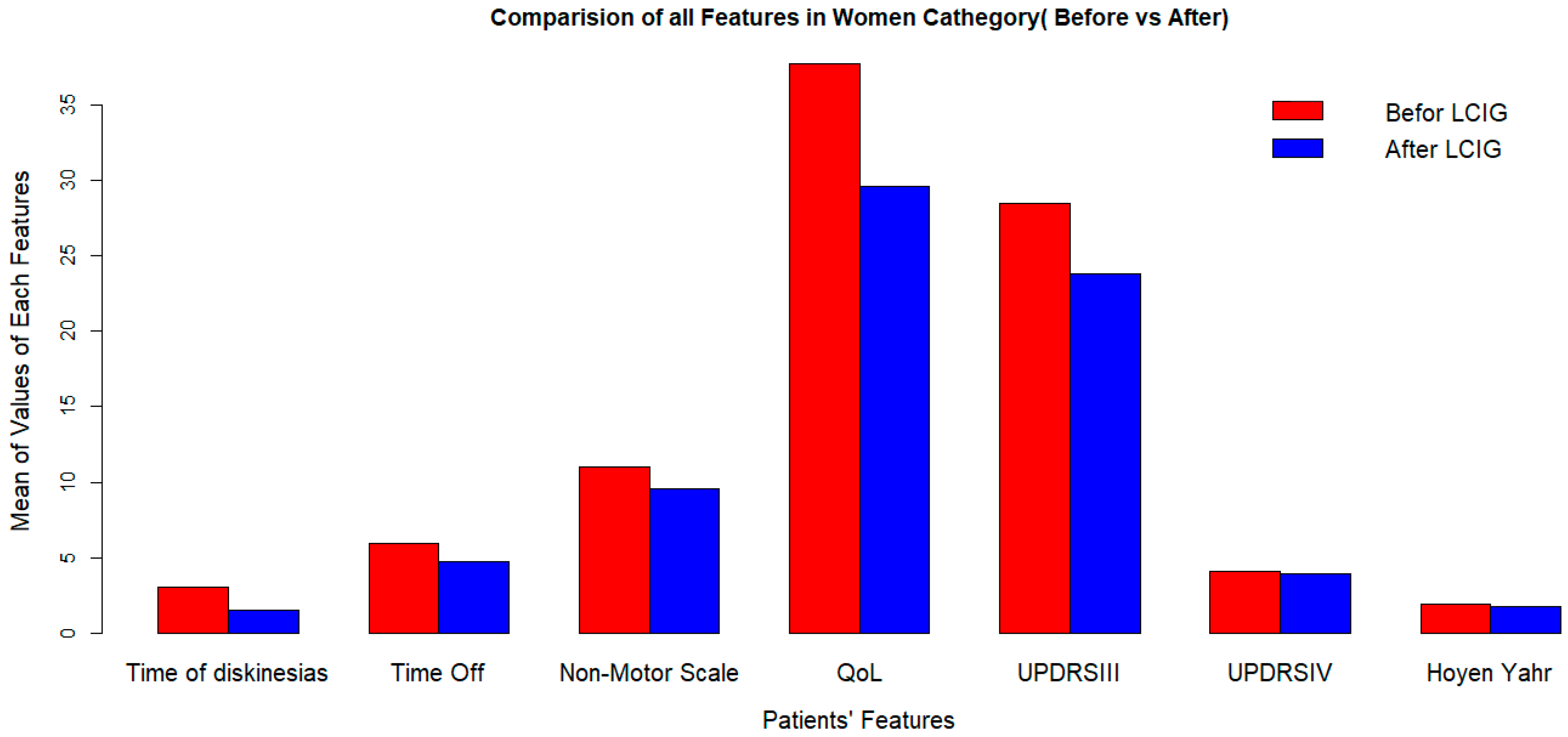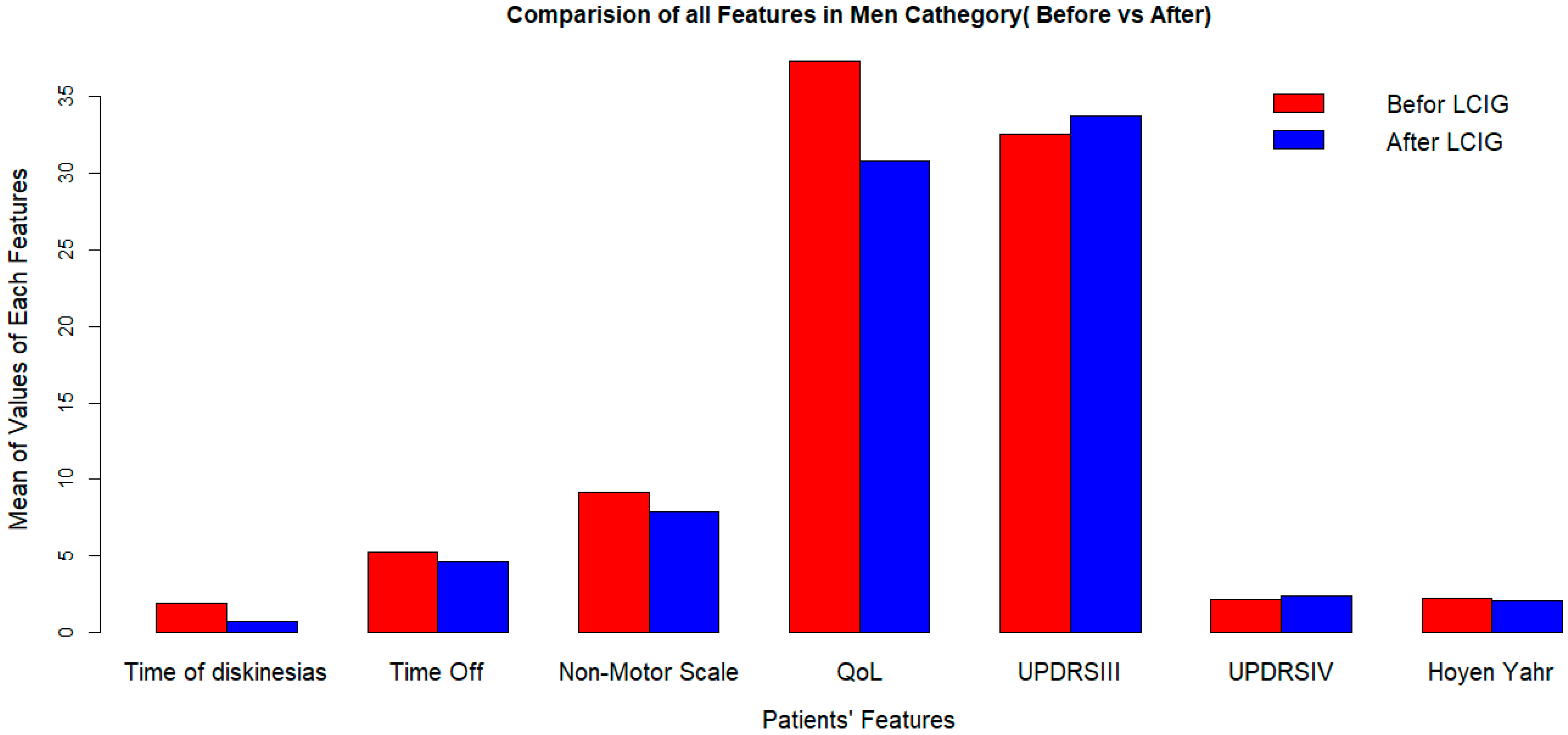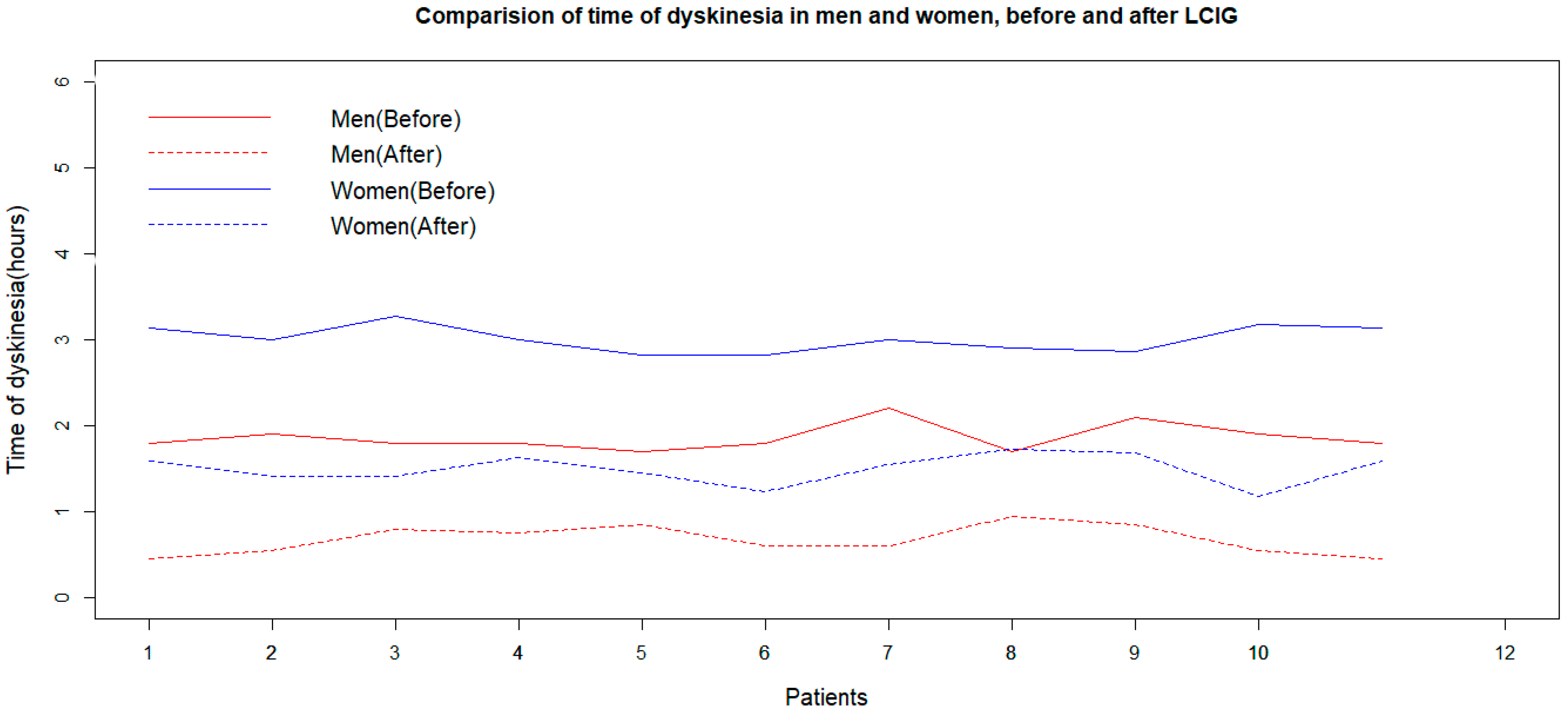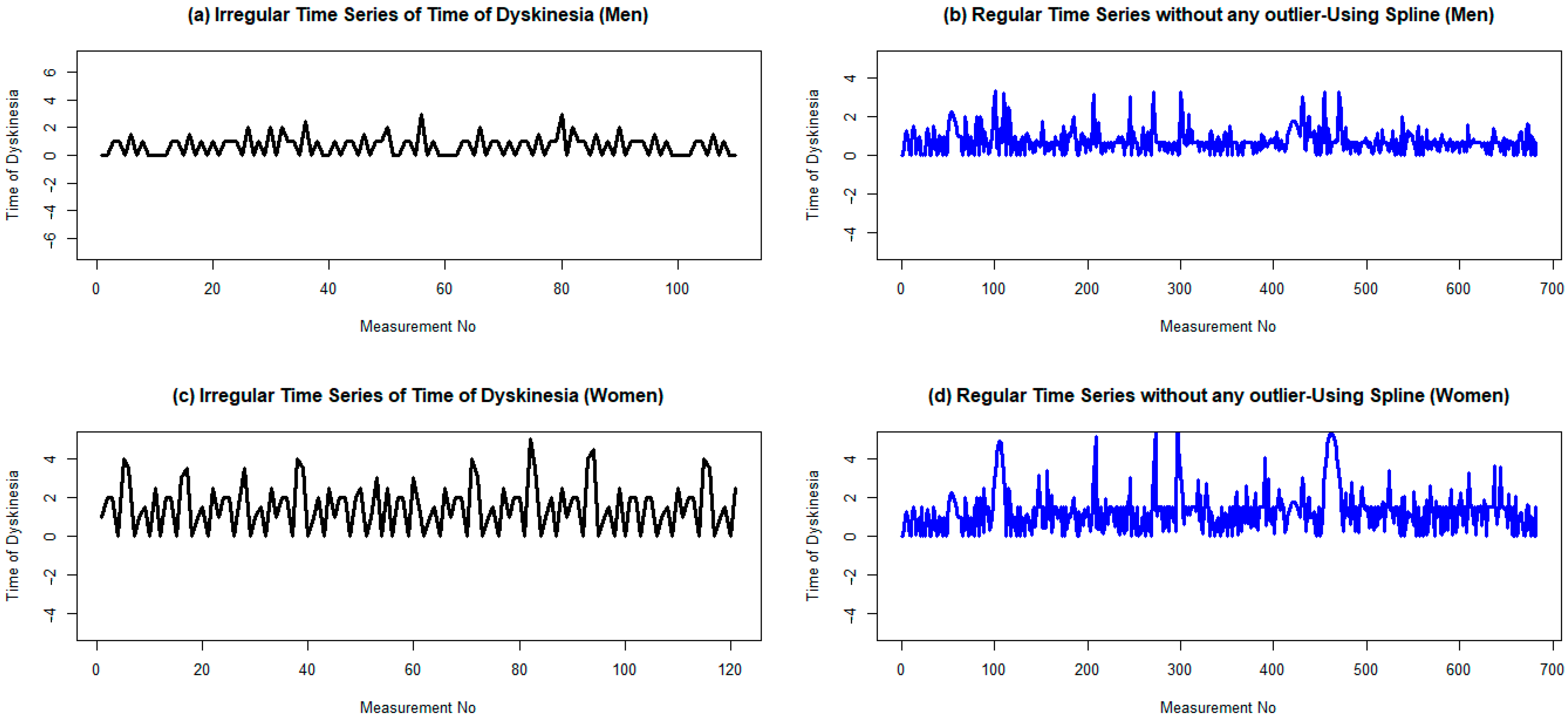An Artificial Neural Network Predicts Gender Differences of Motor and Non-Motor Symptoms of Patients with Advanced Parkinson’s Disease under Levodopa–Carbidopa Intestinal Gel
Abstract
:1. Introduction
2. Materials and Methods
2.1. Study Design
2.2. Statistical Analysis
3. Results
3.1. Multivariate Linear Regression Model
3.2. Mathematical Modeling
3.3. Time Series Models
3.4. LSTM Network
4. Discussion
4.1. Limitations and Strengths
4.2. Future Research Directions/Possible Applications of the Research
5. Conclusions
Supplementary Materials
Author Contributions
Funding
Institutional Review Board Statement
Informed Consent Statement
Data Availability Statement
Conflicts of Interest
References
- Poewe, W.; Seppi, K.; Tanner, C.M.; Halliday, G.M.; Brundin, P.; Volkmann, J.; Schrag, A.E.; Lang, A.E. Parkinson disease. Nat. Rev. Dis. Primers 2017, 3, 17013. [Google Scholar] [CrossRef]
- Chaudhuri, K.R.; Schapira, A.H. Non-motor symptoms of Parkinson’s disease: Dopaminergic pathophysiology and treatment. Lancet Neurol. 2009, 8, 464–474. [Google Scholar] [CrossRef] [PubMed]
- Fasano, A.; Fung, V.S.C.; Lopiano, L.; Elibol, B.; Smolentseva, I.G.; Seppi, K.; Takáts, A.; Onuk, K.; Parra, J.C.; Bergmann, L.; et al. Characterizing advanced Parkinson’s disease: OBSERVE-PD observational study results of 2615 patients. BMC Neurol. 2019, 19, 50. [Google Scholar] [CrossRef] [PubMed]
- Antonini, A.; Odin, P.; Pahwa, R.; Aldred, J.; Alobaidi, A.; Jalundhwala, Y.J.; Kukreja, P.; Bergmann, L.; Inguva, S.; Bao, Y.; et al. The Long-Term Impact of Levodopa/Carbidopa Intestinal Gel on O‘ff’-time in Patients with Advanced Parkinson’s Disease: A Systematic Review. Adv. Ther. 2021, 38, 2854–2890. [Google Scholar] [CrossRef]
- Emrani, S.; McGuirk, A.; Xiao, W. Prognosis and diagnosis of Parkinson’s disease using multi-task learning. In Proceedings of the 23rd ACM SIGKDD International Conference on Knowledge Discovery and Data Mining, Halifax, NS, USA, 13–17 August 2017; pp. 1457–1466. [Google Scholar]
- Shamir, R.R.; Dolber, T.; Noecker, A.M.; Walter, B.L.; McIntyre, C.C. Machine Learning Approach to Optimizing Combined Stimulation and Medication Therapies for Parkinson’s Disease. Brain Stimul. 2015, 8, 1025–1032. [Google Scholar] [CrossRef]
- Efthymiopoulou, E.; Antonoglou, A.; Loupo, B.; Bougea, A. Determination of the motor status of patients with advanced Parkinson’s disease under levodopa-carbidopa intestinal gel using a machine learning model. Acta Neurol. Belg. 2023, 123, 565–570. [Google Scholar] [CrossRef]
- Byeon, H. Is the Random Forest Algorithm Suitable for Predicting Parkinson’s Disease with Mild Cognitive Impairment out of Parkinson’s Disease with Normal Cognition? Int. J. Environ. Res. Public Health 2020, 17, 2594. [Google Scholar] [CrossRef]
- Houdt, G.V.; Mosquera, C.; Nápoles, G. A review on the long short-term memory model. Artif. Intell. Rev. 2020, 53, 5929–5955. [Google Scholar] [CrossRef]
- Kiser, A.C.; Eilbeck, K.; Bucher, B.T. Developing an LSTM Model to Identify Surgical Site Infections using Electronic Healthcare Records. AMIA Jt. Summits Transl. Sci. Proc. 2023, 2023, 330–339. [Google Scholar]
- Shapiro, M.; Shahar, Y. Treatment Prediction in the ICU Using a Partitioned, Sequential, Deep Time Series Analysis. Stud. Health Technol. Inform. 2024, 310, 710–714. [Google Scholar]
- Benvenuto, D.; Giovanetti, M.; Vassallo, L.; Angeletti, S.; Ciccozzi, M. Application of the ARIMA model on the COVID-2019 epidemic dataset. Data Brief. 2020, 29, 105340. [Google Scholar] [CrossRef] [PubMed]
- Yao, T.; Chen, X.; Wang, H.; Gao, C.; Chen, J.; Yi, D.; Wei, Z.; Yao, N.; Li, Y.; Yi, D.; et al. Deep evolutionary fusion neural network: A new prediction standard for infectious disease incidence rates. BMC Bioinform. 2024, 25, 38. [Google Scholar] [CrossRef] [PubMed]
- Zhai, M.; Li, W.; Tie, P.; Wang, X.; Xie, T.; Ren, H.; Zhang, Z.; Song, W.; Quan, D.; Li, M.; et al. Research on the predictive effect of a combined model of ARIMA and neural networks on human brucellosis in Shanxi Province, China: A time series predictive analysis. BMC Infect. Dis. 2021, 21, 280. [Google Scholar] [CrossRef] [PubMed]
- Zhao, Z.; Zhai, M.; Li, G.; Gao, X.; Song, W.; Wang, X.; Ren, H.; Cui, Y.; Qiao, Y.; Ren, J.; et al. Study on the prediction effect of a combined model of SARIMA and LSTM based on SSA for influenza in Shanxi Province, China. BMC Infect. Dis. 2023, 23, 71. [Google Scholar] [CrossRef] [PubMed]
- Hibon, M.; Evgeniou, T. To combine or not to combine: Selecting among forecasts and their combinations. Int. J. Forecast 2005, 21, 15–24. [Google Scholar] [CrossRef]
- Fahn, S.; Elton, R.; Members of the UPDRS Development Committee. Unified Parkinson’s Disease Rating Scale. In Recent Development in Parkinson’s Disease; Fahn, S., Marsden, C., Calne, D., Goldstein, M., Eds.; Macmillan Health Care Information: Florhan Park, NJ, USA, 1987; pp. 153–164. [Google Scholar]
- Chaudhuri, K.R.; Martinez-Martin, P.; Schapira, A.H.; Stocchi, F.; Sethi, K.; Odin, P.; Brown, R.G.; Koller, W.; Barone, P.; Macphee, G.; et al. International multicenter pilot study of the first comprehensive self-completed nonmotor symptoms questionnaire for Parkinson’s disease: The NMSQuest study. Mov. Disord. 2006, 21, 916–923. [Google Scholar] [CrossRef] [PubMed]
- Yesavage, J.A.; Brink, T.L.; Rose, T.L.; Lum, O.; Huang, V.; Adey, M.; Leirer, V.O. Development and validation of a geriatric depression screening scale: A preliminary report. J. Psychiatr. Res. 1983, 17, 37–49. [Google Scholar] [CrossRef]
- Hoehn, M.M.; Yahr, M.D. Parkinsonism: Onset, progression and mortality. Neurology 1967, 17, 427–442. [Google Scholar] [CrossRef] [PubMed]
- Jenkinson, C.; Fitzpatrick, R.; Peto, V.; Greenhall, R.; Hyman, N. The Parkinson’s Disease Questionnaire (PDQ-39): Development and validation of a Parkinson’s disease Summary Index Score. Age Ageing 1997, 26, 353–357. [Google Scholar] [CrossRef]
- Fabbri, M.; Zibetti, M.; Calandra-Buonaura, G.; Contin, M.; Sambati, L.; Mohamed, S.; Romagnolo, A.; Berchialla, P.; Imbalzano, G.; Giannini, G.; et al. Levodopa/Carbidopa Intestinal Gel Long-Term Outcome in Parkinson’s Disease: Focus on Dyskinesia. Mov. Disord. Clin. Pract. 2020, 7, 930–939. [Google Scholar] [CrossRef]
- Zappia, M.; Annesi, G.; Nicoletti, G.; Arabia, G.; Annesi, F.; Messina, D.; Pugliese, P.; Spadafora, P.; Tarantino, P.; Carrideo, S.; et al. Sex differences in clinical and genetic determinants of levodopa peak-dose dyskinesias in Parkinson disease: An exploratory study. Arch. Neurol. 2005, 62, 601–605. [Google Scholar] [CrossRef] [PubMed]
- Russillo, M.C.; Andreozzi, V.; Erro, R.; Picillo, M.; Amboni, M.; Cuoco, S.; Barone, P.; Pellecchia, M.T. Sex Differences in Parkinson’s Disease: From Bench to Bedside. Brain Sci. 2022, 12, 917. [Google Scholar] [CrossRef] [PubMed]
- Santos-García, D.; Laguna, A.; Hernández-Vara, J.; Fonticoba, T.d.D.; Bartolomé, C.C.; Painceiras, M.J.F.; Íñiguez-Alvarado, M.C.; Díaz, I.G.; Jesús, S.; Boungiorno, M.T.; et al. On Behalf Of The Coppadis Study Group Sex Differences in Motor Non-Motor Symptoms among Spanish Patients with Parkinson’s Disease. J. Clin. Med. 2023, 12, 1329. [Google Scholar] [CrossRef] [PubMed]
- Zadikoff, C.; Poewe, W.; Boyd, J.T.; Bergmann, L.; Ijacu, H.; Kukreja, P.; Robieson, W.Z.; Benesh, J.; Antonini, A. Safety of Levodopa-Carbidopa Intestinal Gel Treatment in Patients with Advanced Parkinson’s Disease Receiving ≥2000 mg Daily Dose of Levodopa. Park. Dis. 2020, 2020, 9716317. [Google Scholar] [CrossRef] [PubMed]
- Fernandez, H.H.; Standaert, D.G.; Hauser, R.A.; Lang, A.E.; Fung, V.S.; Klostermann, F.; Lew, M.F.; Odin, P.; Steiger, M.; Yakupov, E.Z.; et al. Levodopacarbidopa intestinal gel in advanced Parkinson’s disease: Final 12-month, open-label results. Mov. Disord. 2015, 30, 500–509. [Google Scholar] [CrossRef]
- Olanow, C.W.; Kieburtz, K.; Odin, P.; Espay, A.J.; Standaert, D.G.; Fernandez, H.H.; Vanagunas, A.; A Othman, A.; Widnell, K.L.; Robieson, W.Z.; et al. Continuous intrajejunal infusion of levodopa-carbidopa intestinal gel for patients with advanced Parkinson’s disease: A randomised, controlled, doubleblind, double-dummy study. Lancet Neurol. 2014, 13, 141–149. [Google Scholar] [CrossRef] [PubMed]
- Slevin, J.T.; Fernandez, H.H.; Zadikoff, C.; Hall, C.; Eaton, S.; Dubow, J.; Chatamra, K.; Benesh, J. Long-term safety and maintenance of efficacy of levodopa-carbidopa intestinal gel: An open-label extension of the double-blind pivotal study in advanced Parkinson’s disease patients. J. Park. Dis. 2015, 5, 165–174. [Google Scholar] [CrossRef] [PubMed]
- Antonini, A.; Yegin, A.; Preda, C.; Bergmann, L.; Poewe, W. Global long-term study on motor and non-motor symptoms and safety of levodopa-carbidopa intestinal gel in routine care of advanced Parkinson’s disease patients; 12-month interim outcomes. Park. Relat. Disord. 2015, 21, 231–235. [Google Scholar] [CrossRef] [PubMed]
- Freire-Alvarez, E.; Kurča, E.; Lopez Manzanares, L.; Pekkonen, E.; Spanaki, C.; Vanni, P.; Liu, Y.; Sánchez-Soliño, O.; Barbato, L.M. Levodopa-Carbidopa Intestinal Gel Reduces Dyskinesia in Parkinson’s Disease in a Randomized Trial. Mov. Disord. 2021, 36, 2615–2623. [Google Scholar] [CrossRef]
- Kovács, N.; Bergmann, L.; Anca-Herschkovitsch, M.; Cubo, E.; Davis, T.L.; Iansek, R.; Siddiqui, M.S.; Simu, M.; Standaert, D.G.; Chaudhuri, K.R.; et al. Outcomes Impacting Quality of Life in Advanced Parkinson’s Disease Patients Treated with Levodopa-Carbidopa Intestinal Gel. J. Park. Dis. 2022, 12, 917–926. [Google Scholar] [CrossRef]
- Standaert, D.G.; Rodriguez, R.L.; Slevin, J.T.; Lobatz, M.; Eaton, S.; Chatamra, K.; Facheris, M.F.; Hall, C.; Sail, K.; Jalundhwala, Y.J.; et al. Effect of levodopa-carbidopa intestinal gel on non-motor symptoms in patients with advanced Parkinson’s disease. Mov. Disord. Clin. Pract. 2017, 4, 829–837. [Google Scholar] [CrossRef] [PubMed]
- Chaudhuri, K.R.; Antonini, A.; Robieson, W.Z.; SanchezSolino, O.; Bergmann, L.; Poewe, W. Burden of non-motor symptoms in Parkinson’s disease patients predicts improvement in quality of life during treatment with levodopa-carbidopa intestinal gel. Eur. J. Neurol. 2019, 26, 581-e43. [Google Scholar] [CrossRef] [PubMed]
- Wu, F.; Zhao, G.; Zhou, Y.; Qian, X.; Baedorf-Kassis, E.; Lehman, L.H. Forecasting Treatment Outcomes Over Time Using Alternating Deep Sequential Models. IEEE Trans. Biomed. Eng. 2023, 71, 1237–1246. [Google Scholar] [CrossRef] [PubMed]
- Latourelle, J.C.; Beste, M.T.; Hadzi, T.C.; Miller, R.E.; Oppenheim, J.N.; Valko, M.P.; Wuest, D.M.; Church, B.W.; Khalil, I.G.; Hayete, B.; et al. Large-scale identification of clinical and genetic predictors of motor progression in patients with newly diagnosed Parkinson’s disease: A longitudinal cohort study and validation. Lancet Neurol. 2017, 16, 908–916. [Google Scholar] [CrossRef]





| Men (before LCIG Treatment) | Men (after LCIG Treatment) | Women (before LCIG Treatment) | Women (after LCIG Treatment) | |
|---|---|---|---|---|
| Age | 70 ± 12.08 | - | 73.45 ± 8.35 | - |
| PD Duration | 14.3 ± 4.83 | - | 14.27 ± 6.52 | - |
| GDS | 8.18 ± 2.09 | - | 6.7 ± 2.62 | - |
| Dyskinesia Duration | 1.86 ± 0.16 | 0.67 ± 0.17 | 3.01 ± 0.15 | 1.49 ± 0.18 |
| “Off” Duration | 5.26 ± 0.25 | 4.57 ± 0.43 | 5.94 ± 0.25 | 4.73 ± 0.52 |
| NMSQ | 9.15 ± 0.24 | 7.89 ± 0.84 | 11.01 ± 0.15 | 9.53 ± 1.27 |
| UPDRS-III (state off) | 32.55 ± 4.78 | 33.76 ± 3.43 | 28.45 ± 2.03 | 23.79 ± 4.78 |
| UPDRS-IV | 2.14 ± 0.12 | 2.34 ± 0.93 | 4.11 ± 0.25 | 3.90 ± 0.09 |
| HY | 2.21± 0.18 | 2.04 ± 0.08 | 1.88 ± 0.10 | 1.75 ± 0.20 |
| PDQ-39 | 37.31 ± 0.94 | 30.77 ± 1.30 | 37.67 ± 0.59 | 29.61 ± 2.19 |
Disclaimer/Publisher’s Note: The statements, opinions and data contained in all publications are solely those of the individual author(s) and contributor(s) and not of MDPI and/or the editor(s). MDPI and/or the editor(s) disclaim responsibility for any injury to people or property resulting from any ideas, methods, instructions or products referred to in the content. |
© 2024 by the authors. Licensee MDPI, Basel, Switzerland. This article is an open access article distributed under the terms and conditions of the Creative Commons Attribution (CC BY) license (https://creativecommons.org/licenses/by/4.0/).
Share and Cite
Bougea, A.; Derikvand, T.; Efthimiopoulou, E. An Artificial Neural Network Predicts Gender Differences of Motor and Non-Motor Symptoms of Patients with Advanced Parkinson’s Disease under Levodopa–Carbidopa Intestinal Gel. Medicina 2024, 60, 873. https://doi.org/10.3390/medicina60060873
Bougea A, Derikvand T, Efthimiopoulou E. An Artificial Neural Network Predicts Gender Differences of Motor and Non-Motor Symptoms of Patients with Advanced Parkinson’s Disease under Levodopa–Carbidopa Intestinal Gel. Medicina. 2024; 60(6):873. https://doi.org/10.3390/medicina60060873
Chicago/Turabian StyleBougea, Anastasia, Tajedin Derikvand, and Efthymia Efthimiopoulou. 2024. "An Artificial Neural Network Predicts Gender Differences of Motor and Non-Motor Symptoms of Patients with Advanced Parkinson’s Disease under Levodopa–Carbidopa Intestinal Gel" Medicina 60, no. 6: 873. https://doi.org/10.3390/medicina60060873







